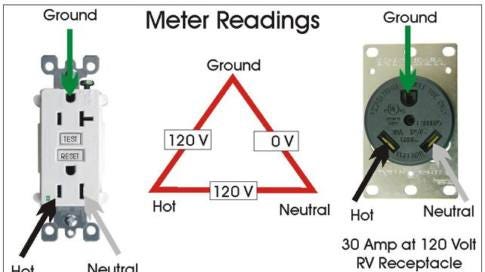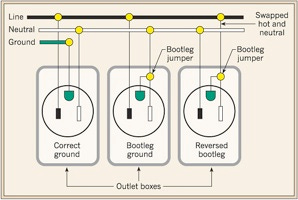Is a Reverse Polarity 30-Amp Outlet Dangerous?
It’s not immediately dangerous, but there’s still a lot that can go wrong…
Dear Mike,
What happens if I have reverse polarity on a 30-amp pedestal? Can I still use it? My surge protector said there is a reverse polarity, which is how I know there’s a problem. My electrician says it doesn’t really matter and to go ahead and plug in. Is that true? Thank you so much for your answer and making these videos!!! —Hosh
Dear Hosh,
Thanks for watching my videos and asking questions. The short answer is that a reverse hot-neutral polarity in a 30- or 20-amp outlet isn’t immediately dangerous. However, it does show that whoever wired it never tested the installation and there might be other problems lurking inside that could be dangerous or even deadly.
What is “Reverse Polarity”
As you can see from this diagram, there are three conductors in a 30-amp pedestal outlet. They’re called Hot, Neutral and Ground. The Hot conductor is typically Black or Red, the Neutral conductor is always White, and the Ground conductor can be Green or Bare Copper.
And looking at the diagram above and the video below, in a properly wired outlet you should measure close to 0 volts between ground and neutral, and around 120 volts between neutral and hot as well as ground and hot.
But if the Hot and Neutral conductors are accidentally reversed during installation you’ll measure around 120 volts between the ground and neutral conductors and 0 volts between ground and hot. And that’s what we call Reverse Polarity.
Is it dangerous?
It’s not immediately dangerous, since your RV is supposed to be wired with the neutral and ground buses separated from each other. That is “unbonded” in the language of an electrician. Since that means both of them are isolated from your RV chassis, then it can’t create a hot-skin voltage.
But what if my RV is incorrectly wired and I plug into this outlet?
That’s the real danger. Since many DIY electricians have rewired RVs over the years, I’ve encountered a number of them with a bonded neutral/ground inside of the RV. If that’s the only thing wrong with the wiring, then plugging into a Reverse Polarity Outlet will immediately trip the 30-amp circuit breaker with spectacular fireworks. Here’s my video on how to test for Reverse Polarity with a standard digital multimeter. Click the picture of the pedestal above or HERE.
However, if your RV also has a broken ground connection plus an internal neutral-ground bond, then plugging it into a pedestal with Reverse Polarity will energize the chassis and skin of your RV with 120-volts AC and at full circuit breaker (20 or 30-amp) current.
Beware of the RPBG
You’ve inadvertently created what I named an RPBG (Reverse Polarity Bootleg Ground). And that’s definitely dangerous. Read more about RPBG miswiring HERE.
Is my electrician correct?
Well, he’s correct that it’s probably not immediately dangerous if your RV is wired properly. However, if it’s not, then a Reverse Polarity Outlet could created a deadly hot-skin voltage on the RV. And if you then touch anything metal on an RV while standing on damp or wet ground, then that fault current can go through your heart, causing it to go into cardiac fibrillation.
So I would say NO, because it could be dangerous and the outlet miswiring condition needs to be corrected sooner rather than later.
Possible consequences?
I worry that any electrician who doesn’t correct a miswired campground outlet (in this case one with Reverse Polarity) and tells you to plug into it could be held liable for any damages or injuries that result from his misinformation. So he needs to correct any wiring errors immediately.
OK, everyone
Remember that electricity is a useful and powerful force, so we all need to pay attention to safety precautions while using it.
Let’s play safe out there…. Mike










Hi Mike. Great stuff! I'm enjoying your posts. Regarding the danger of reverse polarity, I've realized recently that there is another hazard associated with it, and that it switches. Most switches break the hot connection, and if the polarity is reversed, then a switch that normally breaks the hot connection now breaks the neutral, so the load is still hot. Something as simple as a light bulb socket could them present a dangerous shock hazard.
Keep up the great work!
So Mike, a question about clamp DMMs, and perhaps a warning to your readers. I have a Klein CL380, which I have used for several years. All of a sudden, the voktage measurement is totally unreliable getting a various times 61 v, 80, and 100v for a 120 circuit, checked with other meters. The only thing of note, is that the replacement for it (an ideal) says not to have the leads plugged in while using the clamps. I went back to the Klein book, and that warning was there too, just missed it. I know I cannot trust the Klein anymore, but wondered what you guess might have occurred, and whether it is related to having the leads plugged in while using the clamp. The clamp SEEMS to be giving me OK data similar to other meters. I also replaced the batteries to no change.